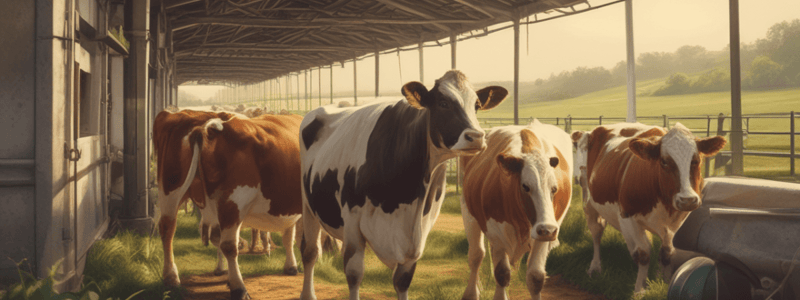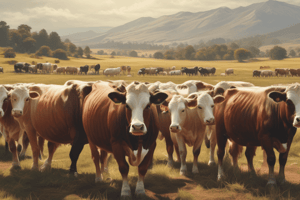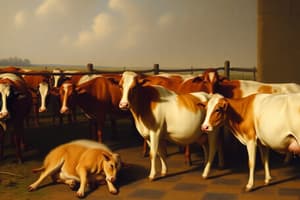Podcast
Questions and Answers
What percentage of calves are born in spring in a dairy herd?
What percentage of calves are born in spring in a dairy herd?
- 70%
- 60%
- 90%
- 80% (correct)
How is a calf's airway cleared after birth?
How is a calf's airway cleared after birth?
- Cow licks the calf
- Farmer uses iodine solution
- Cow is rubbed vigorously
- All of the above (correct)
What is the primary reason for artificial rearing of calves in dairy farming?
What is the primary reason for artificial rearing of calves in dairy farming?
- To improve calf health
- To increase milk production
- To reduce labor costs
- To prevent loss of milk (correct)
Why can't a calf digest concentrate ration at an early age?
Why can't a calf digest concentrate ration at an early age?
What is the sequence of feeds for a calf?
What is the sequence of feeds for a calf?
What is colostrum also known as?
What is colostrum also known as?
What is the duration of gestation in dairy cows?
What is the duration of gestation in dairy cows?
Why is colostrum important for a calf?
Why is colostrum important for a calf?
What is the recommended Body Condition Score (BCS) for heifers at mating?
What is the recommended Body Condition Score (BCS) for heifers at mating?
Why are older cows culled from the herd?
Why are older cows culled from the herd?
What is the purpose of dosing for hoose in overwintering?
What is the purpose of dosing for hoose in overwintering?
What is the target weight for heifers at breeding?
What is the target weight for heifers at breeding?
What is the recommended rate of live weight gain (LWG) for heifers?
What is the recommended rate of live weight gain (LWG) for heifers?
What is the purpose of feeding good quality silage with a DMD of 75% to overwintering heifers?
What is the purpose of feeding good quality silage with a DMD of 75% to overwintering heifers?
What is the percentage of protein in fresh milk?
What is the percentage of protein in fresh milk?
Why should calves be fed colostrum?
Why should calves be fed colostrum?
What is the purpose of introducing concentrates and hay to calves?
What is the purpose of introducing concentrates and hay to calves?
What is a key benefit of grazing calves in a leader-follower system?
What is a key benefit of grazing calves in a leader-follower system?
What is the purpose of ear tagging in calf management?
What is the purpose of ear tagging in calf management?
What should be a key feature of a calf shed?
What should be a key feature of a calf shed?
What is the advantage of feeding calves fresh, palatable grass?
What is the advantage of feeding calves fresh, palatable grass?
What is the purpose of milk replacer in calf management?
What is the purpose of milk replacer in calf management?
Flashcards are hidden until you start studying
Study Notes
Life Cycle of a Replacement Heifer: Birth to 2 Years
- 80% of calves are born in spring, and all calves born in a dairy herd are artificially reared.
- Gestation length is 283 days (9.5 months), and cows are mated in April.
- Before producing milk, cows need to produce a calf, which requires a series of steps after birth:
- Clearing airways of mucus
- Stimulation of circulation through licking or rubbing
- Disinfecting nasals with iodine solution
- Feeding 2-3 liters of colostrum
Calf Rearing
- In dairy farming, all rearing is done artificially to avoid milk loss.
- Calves are reared for two main reasons:
- As replacements for the dairy herd
- For beef production
- Calves cannot digest concentrate ration at an early age due to an underdeveloped rumen.
- The normal feeding sequence is:
- Colostrum
- Natural Milk
- Milk Replacer
- Concentrate ration/Hay/Grass
Colostrum
- Produced for 4-5 days after birth, also known as beestings
- Creamy and dark in color, high in nutrients and antibodies, providing passive immunity to the calf
- Composition:
- Water: 78%
- Solids: 22%
- Protein: 14.9%
- Fat: 6.7%
- Lactose: 2.5%
- Vitamins and Minerals: 1.2%
- Immunoglobins: 6.0%
Milk Replacer
- A powdered milk mixed with water
- Fed to calves after receiving colostrum, with regular feeding times to avoid scour
- Calves have access to hay, concentrates, and fresh water to develop the rumen
Concentrates/Hay/Grass
- Gradually introduced to develop the rumen microflora, referred to as 'scratch factor'
Ear Tagging and BVD
- Bovine Viral Diarrhoea (BVD) is a virus, and animals with this virus must be identified and culled
Housing
- Calves' shed should be:
- Clean, well ventilated, and draught-free
- Have clean bedding
- Access to fresh water
- Cleaned out regularly
Weaning
- Calves are selective grazers and should graze in a Leader-follower system
- Fresh palatable grass provides high live weight gain (LWG) and less chance of disease
Overwintering
- Winter housing at 9 months old
- Fed good quality silage with a Dry Matter Digestibility (DMD) of 75%
- Poor quality silage should be supplemented with concentrates or catch crops
Year 2 - Turning into a Replacement Heifer
- Heifers may be selected to replace older cows in the herd
- Older cows are culled due to:
- Age
- Low milk production
- Health issues
- Grading up the herd improves the genetic merit of the herd
Selecting Replacement Heifers
- Heifers should:
- Have a good body condition score (BCS)
- Be of the correct breed
- Have a good milk production potential
- Be healthy and free of disease
- Have a good temperament
Body Condition Score (BCS)
- Assesses the level of fat reserves in cattle, sheep, and pigs
- Ranges from 1 to 5
- BCS of heifers should be 3.25 at mating and reach a target weight of 300/330kg
Bull Selection for Replacement Heifer
- Economic Breeding Index (EBI) is used to select bulls for breeding
Target Weight for Heifers
- Should have a live weight gain (LWG) of 0.6-0.7kg per day
- Fed grass, silage with 75% DMD ad-lib
Farm Safety
- Important to ensure a safe working environment for farmers and animals
Studying That Suits You
Use AI to generate personalized quizzes and flashcards to suit your learning preferences.




